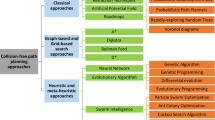Abstract
In this paper, a variable structure control method for a two-link robot arm with/without look-up tables is proposed. The stability of the control system is proven. Robustness against parametric variation and external disturbance is achieved. Suitable controller gains are picked up from the angle-related tables to fulfill the control law. The proposed method retains the benefit of variable structure control and further curtails computation time. An additional advantage is that it is not necessary to measure or observe joint angular velocities.












Similar content being viewed by others
Abbreviations
- qi:
-
the joint angle of joint i
- mi:
-
the mass of link i
- ml:
-
the mass of load
- Ii:
-
the moment of inertia of link i about the axis that passes through the center of mass and is parallel to the Z axis
- li:
-
the length of link i
- lci :
-
the distance between joint i and the center of mass of link i (the center of mass is assumed to be on the straight line connecting these two points and parallel to link i)
References
Itkis U (1976) Control systems of variable structure. John Wiley, New York
Utkin VI (1977) Variable structure systems with sliding mode. IEEE Trans Autom Contr 22:212–222
Utkin VI (1978) Application of equivalent control method to the systems with large feedback gain. IEEE Trans Autom Contr 23:484–486
Hung JY, Gao W, Hung JC (1993) Variable structure control: a survey. IEEE Trans Ind Electron 40:2–22
Young KD, Utkin VI, Özgüner Ü (1999) A control engineer's guide to sliding mode control. IEEE Trans Contr Syst Technol 7:328–342
Antic D, Dimitrijevic S (1999) One application of low-pass filter in sliding mode control with action. Electr Eng 82:33–37
Akpolat ZH, Gokbulut M (2003) Discrete time adaptive reaching law speed control of electrical drives. Electr Eng (DOI 10.1007/s00202-002-0140-8)
Schilling RJ (1990) Fundamentals of robotics analysis and control. Prentice Hall, Englewood Cliffs, N.J.
Chernousko FL, Bolotnik NN, Gradetsky VG (1994) Manipulation robots Dynamics, control, and optimization. CRC Press, Boca Raton, Fla.
Stadler W (1995) Analytical robotics and mechatronics. McGraw-Hill, NewYork
Ivanisevic I, Lumelsky VJ (2000) Configuration space as a means for augmenting human performance in teleoperation tasks. IEEE Trans Syst Man Cybern B 30:471–484
Hertling P, Hog L, Larsen R, Perram JW, Petersen HG (1996) Task curve planning for painting robots-part I: process modeling and calibration. IEEE Trans Robot Autom 12:324–330
Cui Y, Sarkar N (2000) A unified force control approach to autonomous underwater manipulation. In: Proceedings of the 2000 IEEE International Conference on Robotics and Automation, San Francisco, April. IEEE, Piscataway, N.J., pp 1263–1268
Hsu L, Costa RR, Lizarralde F, Da Cunha JPVS (2000) Dynamic positioning of remotely operated underwater vehicles. IEEE Robot Autom Mag 7:21–31
Kavoussanos M, Pouliezos A (2000) Visionary automation of sack handling and emptying. IEEE Robot Autom Mag 7:44–49
Suzuki Y, Tsuchiya S, Okuyama T, Takahashi T, Nagai Y, Kimura S (2001) Mechanism for assembling antenna in space. IEEE Trans Aerosp Electron Syst 37:254–265
Chiaverini S, Siciliano B, Villani L (1999) A survey of robot interaction control schemes with experimental comparison. IEEE Trans Mechatron 49:224–232
Visioli A, Legnani G (2002) On the trajectory tracking control of industrial SCARA robot manipulators. IEEE Trans Ind Electron 49:224–232
Swevers J, Verdonck W, Naumer B, Pieters S, Biber E, (2002) An experimental robot load identification method for industrial application. Int J Robotics Res 21:701–712
Barambines O, Etxebarria V (2000) Robust adaptive control for robot manipulators with unmodelled dynamics. Int J Cybern Syst 31:67–86
Slotine JJ, Sastry SS (1983) Tracking control of non-linear system using sliding surfaces, with application to robot manipulators. Int J Contr 38:465–492
Acknowledgements
The author would like to thank the National Science Council of Taiwan, ROC, for financially supporting this work under Grant NSC91-2213-E155-013.
Author information
Authors and Affiliations
Corresponding author
Rights and permissions
About this article
Cite this article
Huang, Y.J. Variable structure control for a two-link robot arm. Electr Eng 85, 195–204 (2003). https://doi.org/10.1007/s00202-003-0167-5
Received:
Accepted:
Published:
Issue Date:
DOI: https://doi.org/10.1007/s00202-003-0167-5




